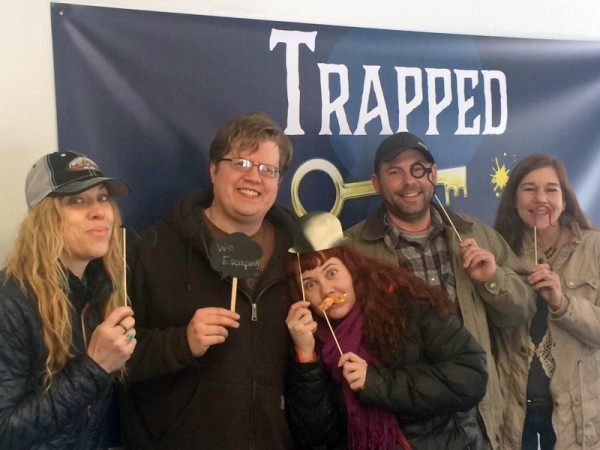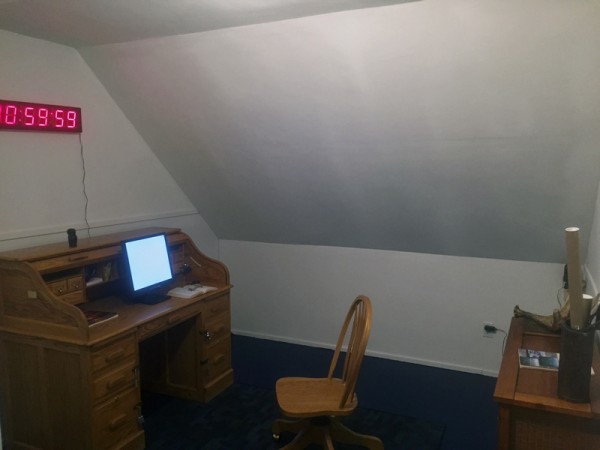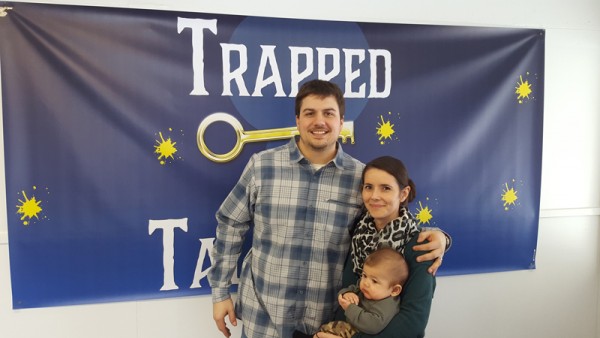
Under most circumstances, being trapped in a small room with a countdown clock would be a bit nerve-wracking, but a new business in Talkeetna aims to make it fun. Trapped in Talkeetna is a live escape room experience, where a team of players has one hour to solve a puzzle in order to escape.
KTNA’s Phillip Manning and his team tried their hand at solving the puzzle – and talked with the owners about why they decided to open Alaska’s first escape room.
“Your team was recruited to be here. You are highly trained intelligence officers and we require your services. There is a spy ring that has been operating in Alaska for the last 6 months. We’ve been aware of this group for some time. In fact, before we brought you in this evening, we’d already recruited 3 other teams to go out into the field and infiltrate this spy ring. Unfortunately, all three of these teams have failed – in fact they’ve disappeared.”
That is the beginning of the briefing given by Ryan and Aubrey Marsolais at Trapped in Talkeetna, Alaska’s first live escape room game.
Teams begin in a briefing room, where they are given information about their coming mission. In our case, the aforementioned spy ring is operating a guide business as a front. Our job, find evidence in the office that tells when and where the attack will come. As Aubrey explains, though, time is limited.
“That means you need to find this information and escape, undetected, within 60 minutes,” she said. “If you can do that, we can send in our extraction teams to get you to safety.”
“However, if you cannot retrieve this information within 60 minutes, we cannot successfully get you out of the building, which means capture is the likely outcome.”
Capture doesn’t sound like much fun. Aubrey tells us that careful inspection of everything in the room is critical.
”When you first walk into this room, you’ll see a desk, cabinets, books, bookshelves.,” she said. “Basically, it looks like any other office, but that’s where the similarities end, because there are clues everywhere.”
The room is much as Aubrey described it. A table, a desk, a computer, knick-knacks, but there are also things you don’t generally find in an office, like locks on drawers and a large red countdown clock on the wall. The clock starts to count down from 60 minutes, and it’s time to get started.

Potential combinations to the locks are in books, on objects, or obtained by solving puzzles. My attempts to maintain journalistic distance and not get too involved in the game didn’t last long.
“2-4-2, 6-7-1, 1-0-3, 0-7-8”
The potential combinations were filling up the chalkboard in the room, but the locks weren’t opening fast enough. In the briefing, we were told we should average a lock every two-to-three minutes. We were falling behind. Then, team member Jenny discovered why she was having trouble.
”Do I line it up with the line? No? Well, I’ve been lining it up wrong this whole time!” Jenny said.
Most of us had been making the same mistake. Precious seconds ticked away, and it looked more and more certain that capture was inevitable.
Fortunately, the Marsolais have a system to provide help to teams that get stuck or miss something important. They are watching the team’s progress from another room through video cameras. If the team needs a hand, a doorbell rings, and a piece of paper slides under the door.
We were given scratch paper and a pencil. Someone was going to have to do some math. Things started picking up, and team member Burney started having success.
”Ha! Got one,” Burney said.
Our locks were opening faster, and we strongly suspected that the locked room next door held the solution to our mission.
A few minutes later, unscrambling a word puzzle lock opened a drawer. Inside lay a key, which made team member Kristy very excited.
”There we go, you got it,” she said. “There’s a key.”
“Another key! Get in the room!”
The door opened. This room was obviously the real heart of the spy operation. Plans, maps, books, and photos line the walls and tables. We were on track, and still had plenty of time.
Then, another setback, the doorbell rang, and a piece of paper slid under telling us to re-check some of the puzzle math.
”Two into nine is eleven…Oh…hang on, hang on, hang on….That’s wrong, too.”
With more clues, better math, and more precious time, the locks kept opening. Then came the team’s nemesis, the maze.
I won’t go into too many details to prevent spoiling the game, but it’s very difficult to complete even a simple brain maze that you can’t see. Suffice it to say that the team was willing to take extreme measures to bypass it when the chance was offered.
“If you’d like to save time and skip the maze, everyone do the robot dance.”
Having saved time, if not dignity, the team opened the last few crucial locks containing the final clues.

The final answer lay behind a keypad lock. The buttons have to be hit in a certain order, and if too many wrong combinations are entered, the system locks down.
With under a minute left, we made our attempt.
“One. Two. Three. Four. Something just unlocked. We found it. We did it.”
As we suspected, the lock hid the final answer the team had come to find. Talkeetna was saved with 45 seconds to spare.
After the game, Ryan Marsolais explained that he had been through two escape rooms before deciding to build one in Alaska.
“I looked one up, and there isn’t any in Alaska,” Ryan said. “Me and my wife were talking and said, ‘Well, Talkeetna’s the place. Let’s open one up.’”
Right now, one room is complete, and a second is in the works. The Marsolais say that the scenarios could change over time, especially if the game starts attracting potential repeat visitors.
With the puzzle solved, a victory photo taken, and everyone still breathing a little heavy from the final minutes, it was time to head out, secure in the knowledge that our town was safe, at least for now.




